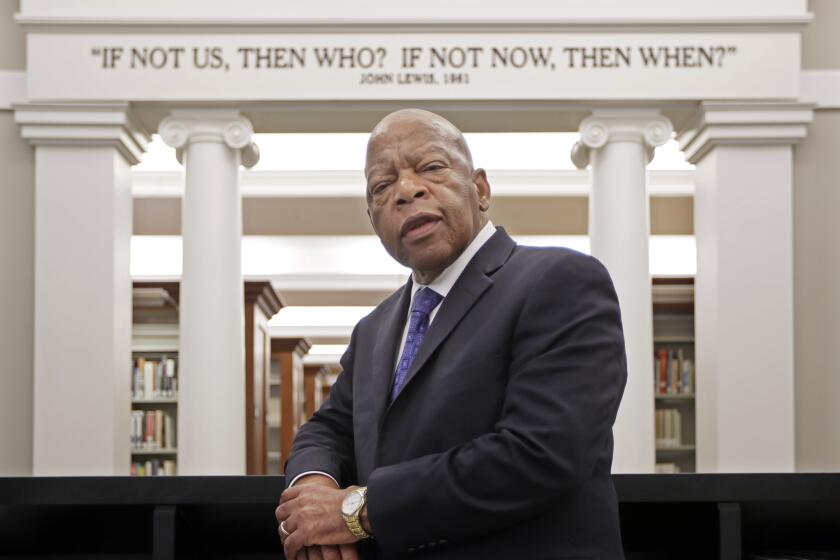How civil rights icon John Lewis wound up in an episode of ‘Arthur’
- Share via
Rep. John Lewis died last week from pancreatic cancer at the age of 80, inspiring heartfelt tributes from politicians, activists and everyday citizens whose lives were changed by his decades of work on behalf of civil rights.
Lewis, whose life will be celebrated beginning Saturday morning at Alabama’s Troy University, famously led the “Bloody Sunday” march in Selma, Ala., in 1965, where he was beaten by state troopers; as recently as last month, he appeared at Black Lives Matter Plaza in Washington, D.C., to support growing racial justice protests across the country. But the longtime congressman also was savvy when it came to conveying his message of social change through pop culture.
He published two autobiographical graphic novels, “March” and “Run”; gamely cosplayed at Comic-Con as a younger version of himself; was a frequent guest on late-night TV — once crowd-surfing on “The Late Show With Stephen Colbert” — and participated in a documentary, “John Lewis: Good Trouble,” released earlier this month.
And as I discovered recently thanks to my 5-year-old daughter, an avid consumer of PBS programming, Lewis also guest-starred in the long-running animated series “Arthur.” As incongruous as it was for me to see one of the most revered civil rights leaders in American history depicted as a cartoon bear, the episode taught my daughter that Lewis was “a special man,” as she recalled to me this week.
John Lewis, an icon of the civil rights era and a longtime member of Congress from Georgia, has died.
In “Arthur Takes a Stand,” which first aired in 2018, Arthur, an 8-year-old anthropomorphic aardvark living in the fictional Elwood City, learns that Lewis will be a guest speaker at his school, Lakewood Elementary. His friend, Sue Ellen, a precociously wise red-headed cat, explains why this is so exciting: “He was a really important civil rights leader in the 1960s and challenged the lack of equal rights for Black Americans!”
But Arthur is upset to learn that his friend, lunch lady Mrs. MacGrady, has been working additional hours to make breakfast for the students at Lakewood. Arthur pleads with Miss Tingley, the principal, to hire an assistant but she brushes him off.
Upset, Arthur dozes off in the library and has a nightmare about Mrs. MacGrady’s workload — then awakens to find the civil rights leader sitting next to him. Lewis encourages him to keep fighting for his friend. “Sometimes people don’t hear the first time. You have to be persistent. But if this means a lot to you, do not give up. Hold your ground. A person with conviction can change the world.”
Arthur decides to organize a cafeteria sit-in to force the school to hire an assistant for Mrs. MacGrady, and Lewis joins in the demonstration; in a twist, it turns out Mrs. MacGrady is an old friend of the Georgia congressman, as both attended the 1963 March on Washington. Miss Tingley relents under pressure and agrees to push for more funding.
“There’s nothing more important than following your conscience,” Lewis tells Arthur at the end of the episode. “If you can do that, you’re always going to sleep well.”
The idea for “Arthur Takes a Stand” dates back to 2017, when Marc Brown, the author of the “Arthur” book series and creator of the TV show, met Lewis at the National Press Club’s Book Fair and Author’s Night. It was his idea to invite Lewis to appear on “Arthur,” which over 23 seasons has frequently tackled social issues, from bullying to climate change. (Last year, Arthur’s teacher Mr. Ratburn came out and got married to a man, resulting in a minor culture-war skirmish when an Alabama public TV station refused to broadcast the episode.)
“It definitely is in line with all that we’ve done always on ‘Arthur,’ which is to bring in diverse viewpoints and interesting guest stars and think about topics that a lot of other kids’ series might not,” said Carol Greenwald, executive producer of “Arthur” and director of children’s media at WGBH, the Boston-based public television station that produces the series.
“We wanted to explore how a young kid can protest, which isn’t about getting a petition signed and writing a letter to your congressperson. That’s all good stuff but not necessarily great TV,” said writer Peter Hirsch. “We thought it would be great for Arthur to identify an injustice that wasn’t necessarily happening to him and to feel strongly enough to want to do something about it. So it was kind of hitting two things: one, how to protest, and two, empathy.”
“Of course, we had to go back and forth with, how much is our character going to get into ‘good trouble’?” Hirsch continued, alluding to Lewis’ own words about civil disobedience. “I think that was the challenge of the episode. We wanted it to have a little bit of bite but not be so out there that the kids were putting themselves in jeopardy.”
Lewis was excited about the opportunity to appear on the show, said Greenwald. “He was really committed to getting his message out to wherever it could go. And in that context he knew it was important to be talking to kids about this stuff.”
But he did have some notes, telling Hirsch in blunt terms when he got the history wrong and weighing in on his character’s design. Producers originally presented him with a few options. Lewis rejected one in which he was depicted as “a really cuddly teddy bear,” Greenwald said. “He said, ‘I just don’t look like that.’” (They opted for a somewhat less cuddly bear.)

The third-act reveal about Mrs. MacGrady’s past as an activist just felt right for the secretly groovy character, says Hirsch. “We had always envisioned her as a child of the ’60s. She’s a lot hipper than you would know unless you talked to her. So we thought, “This is actually the perfect person to be on civil rights marches.”
Greenwald attended Lewis’ voice recording sessions, which were, she recalled, “more challenging than he expected, which of course it always is. But I was really struck by his warmth and his openness and also just his willingness to jump in and have some fun. One of the privileges of this job has been to do these things, and this was the best one, because he’s obviously a hero.”
As racial justice protests spread across the country following the killing of George Floyd, PBS decided to make the episode available again via the PBS Kids app.
“We got a lot of really positive responses” to “Arthur Takes a Stand,” said Greenwald, adding that next month, WGBH plans to release a special short episode of “Arthur” that will frankly discuss race and violence and will include a tribute to Lewis.
“We also got responses from people saying we shouldn’t be showing kids stuff like this: ‘You should protect kids from this.’ Our feeling was maybe some kids can be protected from these issues, but not all kids, and we want all kids to understand what these issues mean to different communities. That’s part of what our goal with ‘Arthur’ is, to be sharing these experiences broadly so kids of all kinds can understand and build empathy.”
More to Read
The complete guide to home viewing
Get Screen Gab for everything about the TV shows and streaming movies everyone’s talking about.
You may occasionally receive promotional content from the Los Angeles Times.







